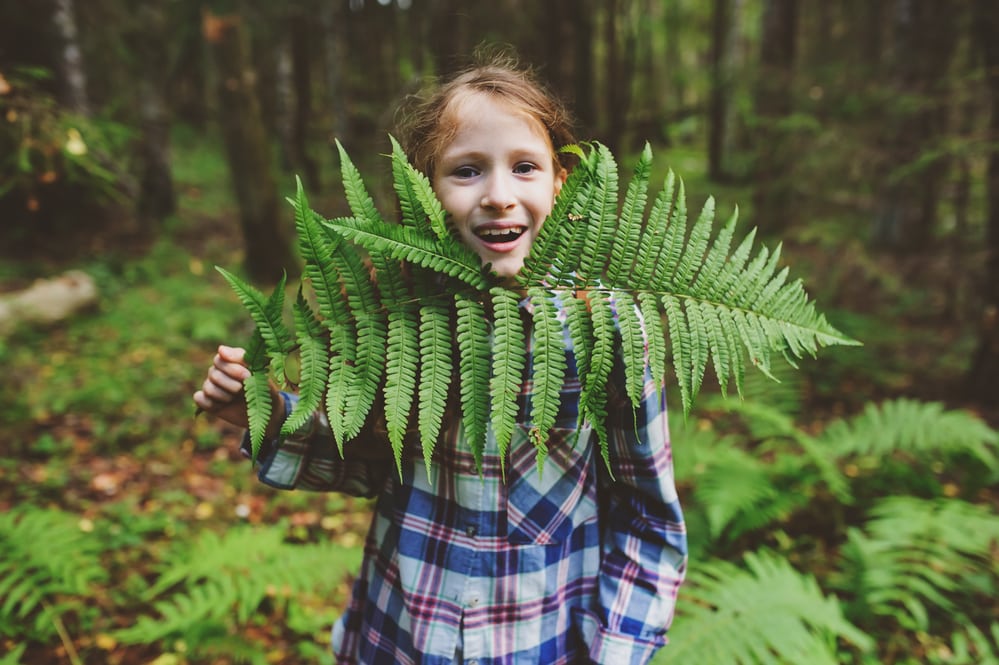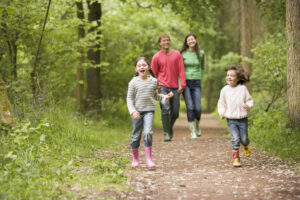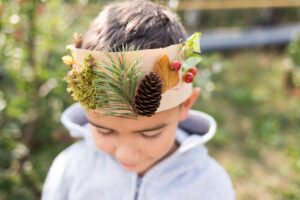Yoga Calm Fundamentals: Why Helping Kids Reconnect with Nature Matters So Much
Updated from the original If you’re GenX or older, there’s a good chance you think of summer as outdoor time and back-to-school as a return to a mostly indoor routine – and daydreams of running about and playing freely...

Updated from the original
If you’re GenX or older, there’s a good chance you think of summer as outdoor time and back-to-school as a return to a mostly indoor routine – and daydreams of running about and playing freely all day in the sun, including plenty of time in green spaces, whether parks, ball fields, or maybe just a vacant lot where green weeds and sunflowers grew tall.
Of course, these days, for many Americans, most time is indoor time. And sedentary. And quite a loss, for science has shown quite clearly that time in nature has real benefits when it comes to both our physical and mental health.
So What Could Be the Benefits of Emphasizing Outdoor Time During the School Year?
One 2012 study, for instance, found that four days in nature increased participants’ problem-solving abilities and creativity by roughly 50%. A 2019 study found that people who spent at least two hours in nature each week reported better health and well-being than those who never spent time in green spaces. It didn’t matter if the two hours were experienced all at once or spread out across the week. The thing that mattered was being in nature.
But wait! There’s more!
A 2015 study found that 50 minutes walking in nature did more to lower anxiety and improve mood and memory than 50 minutes walking in a city. A study of children with ADHD found that their focus improved after time doing outdoor activities. “Moreover,” its authors added “the advantage of green outdoor activities over other activities was consistent for children across a wide range of individual, residential, and case characteristics.”
And that’s just a sample of the large body of research that’s been done so far on the impact of nature on human well-being.
“The Complex Ways in Which People & Nature Are Connected”
In 2022, one group of researchers published a review of just over 300 such studies in the journal Science Advances. The results of their review and analysis showed that the benefits of time in nature are far more expansive than perhaps imagined before and provide a “comprehensive framework for understanding and quantifying the complex ways in which people and nature are connected,” as the Washington Post put it.
In fact, the study authors identified 227 ways that our relationship to nature can impact our health and well-being, both for better and worse.
Researchers found that the highest positive contributions were seen in mental and physical health. Recreation, tourism and aesthetic value appeared to have the greatest impact on human health through the “regenerative” mechanism, or experiencing restorative effects from being in nature such as stress relief, according to the paper. Meanwhile, the highest negative effects are linked to mental health through the “destructive” mechanism, or direct damages associated with the degradation or loss of cultural ecosystem services, the researchers wrote.
“In reality, you don’t just have one pathway,” and the effects aren’t always positive, [study co-author Alexandros] Gasparatos said. “It’s not that if I go to the forest, I receive one thing.”
Connecting Kids with the Outdoors, Indoors
Clearly, there’s no lack of great reasons for moving at least some of children’s education outside, especially in these first months of the academic year, when weather is less of an issue in most places.
But what if you can’t go outside during the school day or can only do so during limited times of the school year?
The Yoga Calm Earth Warriors extension can give you plenty of ideas for integrating outdoor time with your existing curriculum needs and mandates, from science lessons to physical education to language arts, social studies, and more. Its element-themed yoga classes and kid-inspired nature galleries can also help you bring the “outside in”.
One fun activity for little ones starts with your gathering leaves, cones, flowers, and such from the trees on your school property. With these, you can play a game in which you ask the students if they know which trees they belong to and where in the world they might find those trees? Then reveal the surprise: These trees are right there on their own schoolground. At recess, encourage them to see how many they can find by matching the leaves and all to the trees they come from.
Simultaneously, you’ll be helping your students reconnect with the natural world, tapping into their natural fascination with it and how it works. (Remember, for instance, the sense of wonder you felt upon first noticing that some flowers open in the morning and close in the evening, ever responsive to the sun?) This can help develop a sense of environmental stewardship, of the things they can do to help our planet heal.
And, of course, the proven mental health benefits of time in green spaces is no small virtue in the face of our current youth mental health crisis, not to mention the increased stresses that teachers like you are experiencing.
Since we can’t invite you to personally step out into our studio garden with us or meet up right this moment for a leisurely walk through the nearest park, we’d like to leave you with a virtual example that may help you feel and remember the difference that the natural world can make in us – one that features Junebug, the canine costar of our Empower series of brain science-meets-mindful movement videos, embodying the Yoga Calm principle of grounding:
PS: Actually, we can invite you to step into our studio garden in Portland, OR – for our newest workshop, Celebrate the Human Spirit! Slated for August 19 – 20, 2023, the course will include lots of outdoor nature and Earth Warriors activities! Learn More / Register Now

 UsenB
UsenB 


































